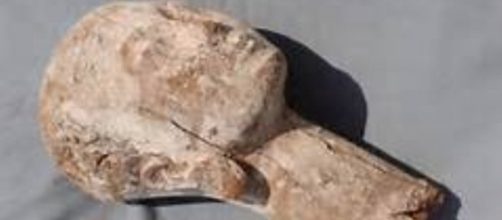Egyptmania, a craze sparked by Napoleon’s incursions, lives on. Consider all the U.S. museum shows about the old Nile this year alone. The list takes in the Brooklyn Museum, the Houston Museum of Natural Sciences, the World Museum in Albuquerque, the Pember Museum in Granville, NY, the Yale Peabody Museum and the San Diego Museum of Man. And that’s not even counting all of the American road shows of the King Tut exhibit.
Spellbound
Our fixation on ancient Egypt is as old as the pyramids. Why? Can it be the old Nile people fascinate us because they didn’t fear death, reckoning on some afterlife?
That was the purpose of the pyramids, wasn’t it – to protect the dead for the world to come? When Herodotus stood before the giant brick structures in the 5th century, he asked, “Why?” Egypt was a question mark back then. But after 20 centuries of oblivion, in 1799 the Rosetta stone was unearthed and told us a lot about the rulers of the land, the pharaoh. Such unearthings have continued ever since as per The Baltimore Post screamer on Oct. 25, “Statue of Egyptian queen unearthed near Giza pyramids.”
Heads up!
Made of foot-long wood, the “statue” is a disembodied head said to have been sculpted some 4,000 years ago of the queen of the Nile, Ankhnespepy II. The relic was found in what’s been described by Egypt’s Ministry of Antiquities as “a disturbed layer of earth” near the queen’s tomb.
If you’re a cynic like me when it comes to sudden treasure finds, you may wonder how a life-size head could be “found” so many centuries later in topsoil. Did it suddenly rise to the near surface all the way from its likely place in the deep bowels of a tomb?
On the level
I asked a practicing archaeologist, Edward Schneider, who made clear that there’s a natural unearthing of ancient relics. “We find legitimate artifacts in disturbed contexts all the time.” By way of illustration, he conjured a story of Indians a thousand years ago spending a week camping, using fire pits and making stone tools. The debris from that week would accumulate on the ground, and the stone tools would get buried in soil from the movement by way of water and wind.
And if a century later, a farmer tills the earth those Indian relics would get moved around and the context that could clue us into the exact spot they came from would be lost. “But they are still real artifacts,” Schneider said.
To be continued
The same goes for the 4,000-year-old wooden statue, he said. “The ancient work can tell us a lot, but the context in which it was used has been lost.” My guess is that the head came from the tomb because wood would need an airless place to endure. The Ministry of Antiquities expects more such finds, and so the search goes on. Egyptmania lives.


